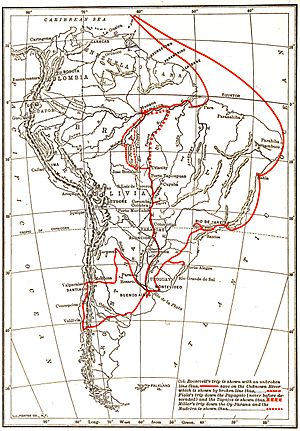Roosevelt–Rondon Scientific Expedition facts for kids

The initial members. From left to right (seated): Father Zahm, Rondon, Kermit, Cherrie, Miller, four Brazilians, Roosevelt, Fiala. Only Roosevelt, Kermit, Cherrie, Rondon and the Brazilians would descend the River of Doubt.
|
|
| Date | December 1913 – April 1914 |
|---|---|
| Location | River of Doubt (now Roosevelt River), Brazil |
| Participants | Theodore Roosevelt Cândido Rondon Kermit Roosevelt George Kruck Cherrie |
| Outcome | Successful exploration of the River of Doubt |
| Deaths | 3 |
The Roosevelt–Rondon Scientific Expedition (in Portuguese: Expedição Científica Rondon–Roosevelt) was an exciting journey into the Amazon basin. It happened in 1913 and 1914. The main goal was to explore a mysterious river called the "River of Doubt."
This adventure was led by two famous people. One was Theodore Roosevelt, who used to be the President of the United States. The other was Colonel Cândido Rondon, a brave Brazilian explorer. He had found the start of this river a few years earlier. The expedition also collected many new types of animals and insects for science. Later, the river was named "Rio Roosevelt" to honor the former president. He almost died during this very tough trip.
Contents
Starting the Adventure: How Did It Begin?
After losing an election in 1912, Theodore Roosevelt wanted a new challenge. He first planned a speaking tour in South America. Then, he thought about a trip down the Amazon River.
But the government of Brazil had a different idea. They asked Roosevelt to join Colonel Rondon. Rondon was going to explore the unknown River of Doubt. Roosevelt loved adventure and agreed right away.
Roosevelt's son, Kermit Roosevelt, also joined the trip. His mother insisted he go to help protect his father. The expedition began in December 1913. They started in Cáceres, a small town in Brazil.
They traveled to Tapirapuã, where Rondon had found the river's source. From there, they went through thick forests. Then they crossed plains on top of the Parecis plateau. They finally reached the River of Doubt on February 27, 1914.
At this point, food was running low. So, the expedition split up. Some members, like Father Zahm, went a different way. The main group continued down the River of Doubt. This group included the Roosevelts, Colonel Rondon, and American naturalist George Kruck Cherrie. They also had 15 Brazilian helpers called camaradas.
Facing Big Problems on the River
The expedition faced many problems almost from the start. Insects and diseases like malaria made everyone sick. They had constant fevers and painful wounds. Their heavy wooden canoes were not good for the many rapids. Canoes were often lost, and building new ones took days.
They did not have enough food, so they often went hungry. The native Cinta Larga tribe watched the expedition from the jungle. They could have attacked, but they let the group pass. Sadly, three members of the expedition did not return. One drowned in the river, and two others were lost during a difficult situation.
By the time they were only a quarter of the way down the river, everyone was exhausted. They were sick from hunger, disease, and hard work. Hauling canoes around rapids was incredibly tough. By the end, almost everyone was sick or hurt, except for Colonel Rondon.
Roosevelt himself was very ill. He had a deep cut on his leg that got infected. Everyone worried he might not survive. Luckily, they met "rubber men" or seringueiros. These were poor workers who collected rubber from trees. They helped the team travel the rest of the river. This part of the river had fewer rapids.
The expedition reunited on April 26, 1914. A Brazilian and American rescue team met them. Roosevelt received medical help as they returned to Manaus. Three weeks later, a very weak Roosevelt arrived home. He was greeted as a hero in New York. His health never fully recovered after the trip. He passed away less than five years later.
Was the Discovery Real?
When Roosevelt returned, some people doubted his story. They wondered if he had really explored the river. Even though he was still weak, Roosevelt was upset by these doubts. He gave speeches to prove his journey. He spoke to the National Geographic Society in Washington, D.C. and the Royal Geographical Society in London. These talks mostly stopped the criticisms.
To finally prove his discoveries, another explorer named George Miller Dyott went down the river in 1927. He confirmed everything Roosevelt had said.
In 1992, a modern expedition followed the same path. This trip had twenty people, including Roosevelt's great-grandson, Tweed Roosevelt. They completed the nearly 1000-mile journey in 33 days. Unlike the original team, they could navigate most rapids safely. They found places and described plants and insects just as the first expedition had. A documentary about this trip was shown on PBS.
The Expedition in Movies
The amazing story of this expedition has been told in other ways too.
- In 2021, a Brazilian TV show called The American Guest was released. It had four episodes and showed the expedition. Aidan Quinn played Theodore Roosevelt, and Chico Diaz played Cândido Rondon.
See also
 In Spanish: Expedición científica Roosevelt-Rondon para niños
In Spanish: Expedición científica Roosevelt-Rondon para niños


